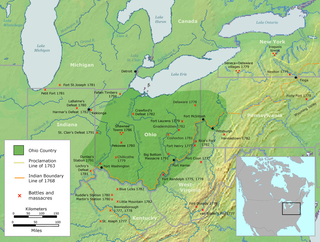 W
WThe Big Bottom massacre occurred on January 2, 1791, near present-day Stockport now in Morgan County, Ohio, United States. It is considered part of the Northwest Indian Wars, in which aboriginal Americans in the Ohio Country confronted American settlers, regular soldiers and militia, seeking to expel them from their territory.
 W
WThe siege of Dunlap's Station was a battle that took place on January 10–11, 1791, during the Northwest Indian War between the Western Confederacy of American Indians and European-American settlers in what became the southwestern region of the U.S. state of Ohio. This was one of the Indians' few unsuccessful attacks during this period. It was shortly after the Harmar Campaign attacks and unprecedented defeat of U.S. Army forces. A few months after the siege, the United States Army suffered a major defeat at the hands of the Indians.
 W
WThe Battle of Fallen Timbers was the final battle of the Northwest Indian War, a struggle between Native American tribes affiliated with the Western Confederacy and their British allies, against the nascent United States for control of the Northwest Territory. The battle took place amid trees toppled by a tornado near the Maumee River in northwestern Ohio at the site of the present-day city of Maumee, Ohio.
 W
WThe Siege of Fort Recovery, 30 June – 1 July 1794, was a battle of the Northwest Indian War, fought at the present-day village of Fort Recovery, Ohio. A large force of warriors in the Western Confederacy attacked a fort held by United States soldiers deep in Ohio Country. The United States suffered heavy losses, but maintained control of the fort. The battle exposed a division in the Western Confederacy's military strategy at a time when they seemed to hold the advantage, and the United States pressed farther into the Northwest Territory.
 W
WThe Harmar campaign was an Autumn 1790 attempt by the United States to subdue Native Americans nations in the Northwest Territory that were seen as hostile. The campaign was led by General Josiah Harmar, and is considered a significant campaign of the Northwest Indian War. The campaign ended with a series of battles from 19–21 October 1790 near the Miami villages of Kekionga. These were all overwhelming victories for the Native Americans, and are sometimes collectively referred to as Harmar's Defeat.
 W
WThe Blackberry Campaign is the name given to a May 1791 expedition led by Charles Scott against Native Americans of the lower Wabash Valley, primarily Wea, Kickapoo, Miami, and Potawatomi. The intent of the campaign was to demonstrate the vulnerability of Native American villages in the Northwest Territory, to take captives who could be used for peace negotiations, and to keep the forces of the Western Confederacy off balance in preparation for a larger 1791 led by Arthur St. Clair. The name Blackberry Campaign was given because soldiers stopped to pick berries to supplement their food supplies.
 W
WSt. Clair's defeat, also known as the Battle of the Wabash, the Battle of Wabash River or the Battle of a Thousand Slain, was a battle fought on 4 November 1791 in the Northwest Territory of the United States of America. The U.S. Army faced the Western Confederacy of Native Americans, as part of the Northwest Indian War. It was "the most decisive defeat in the history of the American military" and its largest defeat ever by Native Americans.